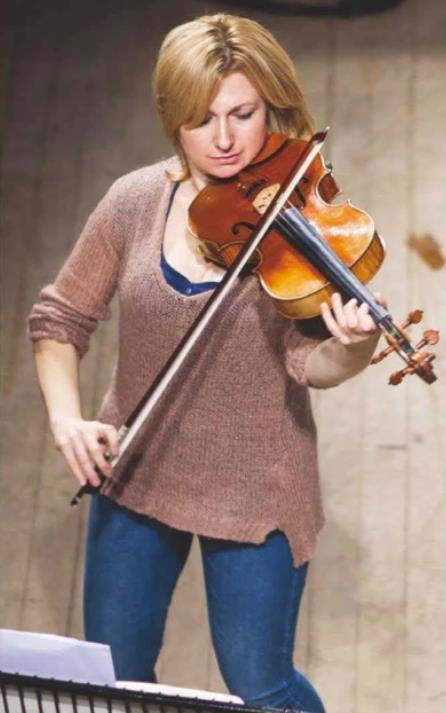The British violist works towards chamber and solo recitals that include pieces by Hindemith and Schoenberg. From 2016

Discover more Featured Stories like this in The Strad Playing Hub.
This article was published in The Strad June 2016 issue
My lifestyle doesn’t afford long stretches of practice time; I have to plan carefully to make sure I manage a minimum of two hours a day on top of work, parenting, rehearsals and other studying. This might mean that I do four 30-minute practice sessions in a day, or six sessions of 20 minutes each.
I need to be efficient and focused, and to eliminate distractions, so the first thing I do is switch off my phone. Then I ask myself what I can achieve in the time I have and set myself goals. These change according to where I am in the run-up to a performance.
At the moment I am working on the first viola part of Schoenberg’s Verklärte Nacht and on Brahms’s A major Piano Quartet op.26 for concerts in Japan with pianist Lars Vogt, violinist Christian Tetzlaff and cellist Tanja Tetzlaff. I’m also practising Hindemith’s Solo Sonata op.25, Biber’s Passacaglia, Bach’s C major Cello Suite, Vieuxtemps’s Capriccio and Stravinsky’s Elegy, for solo viola recitals at the Menuhin School this July and at the Musique à Flaine academy in the French Alps, where I’ll be teaching from 13 to 26 August.
The fourth movement of the Solo Sonata is like an angry outburst. Hindemith, himself a viola player, wrote on the part, ‘Beauty of tone is incidental’. (No viola jokes, please!) This movement is full of vitriolic rage. I have to play in the lower half of the bow for maximum power and weight; the bow needs to sit deeply in my hand, with downward contact coming through a heavy right shoulder, my upper arm weighing down on my middle fingers, into the bow stick, and consequently into the string.
As a general rule, when I’m playing in the lower half of the bow I use my upper arm to play; when playing in the upper half, I use my elbow joint to extend my arm away from the body. This movement doesn’t call for the bow to be used any higher than the middle, and the trick is to play loudly while remaining loose physically, in order to preserve stamina. I use the bow hair flat on the string for maximum contact, and find a contact point close to the bridge, listening carefully to find the place with the most volume, just before the sound breaks. That contact point requires me to balance bow speed with arm weight. I am careful not to push downwards into the instrument, or the sound will become forced, thin and harder to produce.
To see what I need to improve, and to give me a clearer idea of what to work on and how, I use a small camera to video myself, then play myself back in slow motion. This helps me to build on my idea of how I might like my ideal performance to look and sound. Today, for example, for the string-crossings I focus on swinging my arm loosely and swiftly from the upper-arm using the minimum change of angle necessary to catch the required string. The bow contact releases momentarily as it traverses the middle strings, then re-enters contact on the double-stop on the upper strings.
Some of the most sublimely beautiful and intimate music in Verklärte Nacht risks sounding loud, busy and angular because of the intricate string writing. In many passages the principle that ‘every string-crossing contains a double-stop’ is invaluable; keeping this in mind can mean the difference between a beautiful, intimate, legato passage that sounds effortless, and a phrase that sounds broken up.
So that the bow can roll across easily into the next string, I make sure that the finger I use on the ‘arrival’ string is prepared and placed down before the string-crossing occurs. My vibrato has to be continuous, both during my finger preparation and between the notes sounding. I also have to know where the string-crossing movement is coming from: is it a small bow stroke from the fingers, or a roll across the strings from the arm? I make my decision in response to the character and dynamic of the music.
A few weeks before a concert, my aim is to be prepared in terms of stamina and concentration, and to know exactly how I want the character of the music to come across. To finish today’s practice, I play through both pieces from beginning to end.
Read: 6 technical ways for improving your practice
Read: Top tips for putting the joy into practice
This article was published in The Strad June 2016 issue
The number one source for playing and teaching books, guides, CDs, calendars and back issues of the magazine.
In The Best of Technique you’ll discover the top playing tips of the world’s leading string players and teachers. It’s packed full of exercises for students, plus examples from the standard repertoire to show you how to integrate the technique into your playing.
The Strad’s Masterclass series brings together the finest string players with some of the greatest string works ever written. Always one of our most popular sections, Masterclass has been an invaluable aid to aspiring soloists, chamber musicians and string teachers since the 1990s.
American collector David L. Fulton amassed one of the 20th century’s finest collections of stringed instruments. This year’s calendar pays tribute to some of these priceless treasures, including Yehudi Menuhin’s celebrated ‘Lord Wilton’ Guarneri, the Carlo Bergonzi once played by Fritz Kreisler, and four instruments by Antonio Stradivari.













































No comments yet